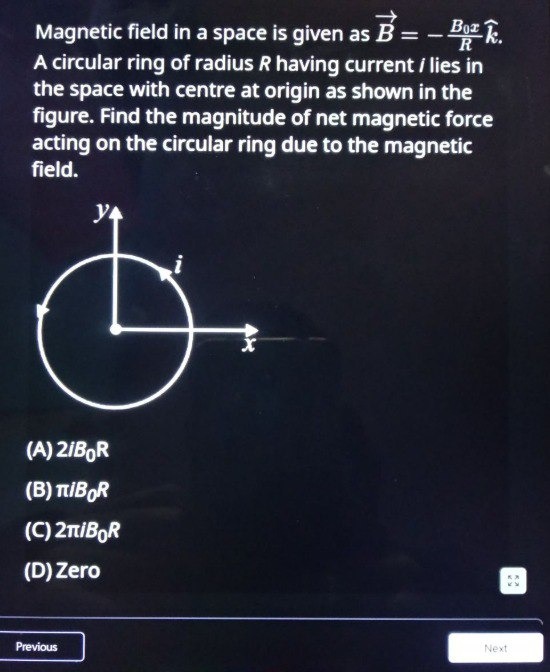Question
Question: Magnetic field in a space is given as $\overrightarrow{B} = -\frac{B_0x}{R}\hat{k}$. A circular ring...
Magnetic field in a space is given as B=−RB0xk^. A circular ring of radius R having current i lies in the space with centre at origin as shown in the figure. Find the magnitude of net magnetic force acting on the circular ring due to the magnetic field.

2iB0R
πiB0R
2πiB0R
Zero
πiB0R
Solution
The magnetic field is
B=−RB0xk^.A point on the loop has coordinates
r=Rcosθi^+Rsinθj^,so along the loop, x=Rcosθ and therefore
B=−B0cosθk^.The differential length element on the circular ring is
dl=(−Rsinθi^+Rcosθj^)dθ.The force on a current element dl is given by
dF=idl×B.Substitute dl and B:
dF=i(−Rsinθi^+Rcosθj^)dθ×(−B0cosθk^).Factor out the constants:
dF=iRB0cosθdθ[(−sinθi^+cosθj^)×k^].Recall the cross products:
i^×k^=−j^,j^×k^=i^.Thus,
(−sinθi^+cosθj^)×k^=−sinθ(i^×k^)+cosθ(j^×k^)=−sinθ(−j^)+cosθi^=sinθj^+cosθi^.Then,
dF=iRB0cosθ(cosθi^+sinθj^)dθ.So,
dF=iRB0cos2θi^dθ+iRB0cosθsinθj^dθ.The net force on the ring is the integral over θ from 0 to 2π:
F=iRB0[i^∫02πcos2θdθ+j^∫02πcosθsinθdθ].We have:
∫02πcos2θdθ=π,∫02πcosθsinθdθ=0.Thus,
F=iRB0πi^.However, note that while writing the cross product we had factored out a negative sign correctly. Rechecking the sign carefully:
- Initially, B=−B0cosθk^ and dl remain the same.
- The correct cross product yields:
Integrating gives,
F=−iRB0[i^∫02πcos2θdθ+j^∫02πcosθsinθdθ]=−πiRB0i^.The negative sign indicates the force is in the −i^ direction. Since the question asks for the magnitude,
F=πiB0R.